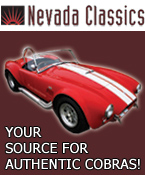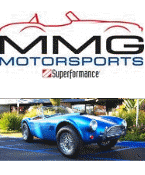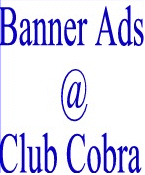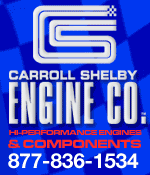 
 Main Menu
Main Menu
|
 Nevada Classics
Nevada Classics
|
 Advertise at CC
Advertise at CC
|
 November 2025
November 2025
|
| S |
M |
T |
W |
T |
F |
S |
| |
|
|
|
|
|
1 |
| 2 |
3 |
4 |
5 |
6 |
7 |
8 |
| 9 |
10 |
11 |
12 |
13 |
14 |
15 |
| 16 |
17 |
18 |
19 |
20 |
21 |
22 |
| 23 |
24 |
25 |
26 |
27 |
28 |
29 |
| 30 |
|
|
|
|
|
|
|
 CC Advertisers
CC Advertisers
|
|

04-06-2009, 10:40 AM
|
|
CC Member

|
|
|
Join Date: Aug 2007
Cobra Make, Engine: 31XX Car
Posts: 374
|
|

 Not Ranked
Not Ranked
 New Engine Woes
New Engine Woes
With all the touting of newly produced FE parts, everyone seems to be forgetting the biggest shortcomings. These new engine parts are often produced by small outfits which don't have the resources or production volumes don't support the level of extensive QA that Ford had. The inspector at these shops can often be the owner or has to report to the owner and what gets let out the door will be correlated with how profits are going.
Even when parts are coming out looking pretty good, they still usually have more variability than OE Ford parts. For example, I've seen at my local engine builder how you often have to play games with the new parts like elongating pushrod holes in intakes because of interference, which is far more rare in OE parts.
From what I've seen designs of new aftermarket parts are also typically not developed to the same degree as OE items with the same diverse group of highly educated & skilled engineers and technicians from various disciplines (structural experts, metallurgists, etc). Sure, certain areas of the new parts have been beefed up, but that is often accompanied by alot of extra material where it isn't necessary. For example, I've seen numerous Blue Thunder heads at my local engine guy's shop and the general production quality looks decent (better than Dove), but they are so porky with excess aluminum it's not funny. That approach wouldn't make it far in F1 circles.
For what the original 427 engine was intended for, less than 500hp but usually good for at least 600, it's hard to beat the product. There are just a few areas (like rod bearings a bit too large in diameter and too narrow, which is primarily responsible for the windowed blocks) that if addressed make it a nice engine - and most of that stuff was being corrected by race teams back in the 60's, like using Chrysler rod bearings. The biggest problem with the old parts is finding anything decent left, as Keith has mentioned. All the problems you can experience with a new aftermarket part can sometimes negate the advantages.

|

04-06-2009, 11:02 AM
|
 |
CC Member

|
|
|
Join Date: Jul 2005
Location: Virginia Beach, Va & Port Charlotte, Fl.,
Posts: 2,291
|
|

 Not Ranked
Not Ranked

Quote:
Originally Posted by Dcmgt

With all the touting of newly produced FE parts, everyone seems to be forgetting the biggest shortcomings. These new engine parts are often produced by small outfits which don't have the resources or production volumes don't support the level of extensive QA that Ford had. The inspector at these shops can often be the owner or has to report to the owner and what gets let out the door will be correlated with how profits are going.
Even when parts are coming out looking pretty good, they still usually have more variability than OE Ford parts. For example, I've seen at my local engine builder how you often have to play games with the new parts like elongating pushrod holes in intakes because of interference, which is far more rare in OE parts.
From what I've seen designs of new aftermarket parts are also typically not developed to the same degree as OE items with the same diverse group of highly educated & skilled engineers and technicians from various disciplines (structural experts, metallurgists, etc). Sure, certain areas of the new parts have been beefed up, but that is often accompanied by alot of extra material where it isn't necessary. For example, I've seen numerous Blue Thunder heads at my local engine guy's shop and the general production quality looks decent (better than Dove), but they are so porky with excess aluminum it's not funny. That approach wouldn't make it far in F1 circles.
For what the original 427 engine was intended for, less than 500hp but usually good for at least 600, it's hard to beat the product. There are just a few areas (like rod bearings a bit too large in diameter and too narrow, which is primarily responsible for the windowed blocks) that if addressed make it a nice engine - and most of that stuff was being corrected by race teams back in the 60's, like using Chrysler rod bearings. The biggest problem with the old parts is finding anything decent left, as Keith has mentioned. All the problems you can experience with a new aftermarket part can sometimes negate the advantages.
|
I guess I need to tell my builder to dump his 5 axis CNC block machine and start looking for the "accurate" Ford core-shift specials.. I'd heard for every "good" 427 block that was made one went back at the factory for scrap and melt down due to tolerance/casting inconsistencies. I'll take any knowledgeable qualified, CNC equipped shop over Ford of yester-year (60s & 70s). For quality, metallurgy and a host of reasons.
Dave
__________________
Too many toys?? never!
|

04-06-2009, 11:57 AM
|
|
CC Member

|
|
|
Join Date: Aug 2007
Cobra Make, Engine: 31XX Car
Posts: 374
|
|

 Not Ranked
Not Ranked
 New Part Problems
New Part Problems
Quote:
Originally Posted by undy

I guess I need to tell my builder to dump his 5 axis CNC block machine and start looking for the "accurate" Ford core-shift specials.. I'd heard for every "good" 427 block that was made one went back at the factory for scrap and melt down due to tolerance/casting inconsistencies. I'll take any knowledgeable qualified, CNC equipped shop over Ford of yester-year (60s & 70s). For quality, metallurgy and a host of reasons.
Dave
|
Those 5 axis CNC machines didn't stop Genesis from sending slews of mis-machined blocks to all sorts of engine shops - among a number of problems, cam tunnels were so bad they came in from one end half way and then from the other end to meet up and they were off some horrendous amount! The important aspect is shops like Genesis, Dove, etc send stuff out like this, vs Ford would tend to catch this so that when you received a part it would go together without jumping through major hoops.
Core shift is a tolerance just like any other dimension and parts at large companies like Ford that end up outside the BP range are reviewed by educated specialists to determine whether they are acceptable to send out as is, rework or scrap......I would rather have that scenario than a high school educated machinist at a small shop with a relatively narrow scope of experience to be making such calls. Whether it be aircraft or autos, parts are custom selected for the most demanding applications and always have been. Presidential aircraft are not allowed to use components that have been through the "MRB" (Material Review Board) because of non-conformities and even the best automotive race engine parts made today are individually inspected and picked by the top NASCAR teams.
There is alot of BS out in the automotive field. I did some fairly extensive research and analysis of rocker arms for a vintage factory Shelby American race engine I recently finished. The general philosophy with the engine was to stay as stock as possible, but not expose myself to excessive risk that could destroy castings, etc that could not be replaced. My initial thought was to go with a steel roller tip rocker, but after multiple spread sheets of rocker kinematics, mock ups and phone conversations with the top designers at most of the rocker arm companies, leading race engine shops (incl NASCAR and an F1 designer) and others, the stock Ford rocker surfaced as the best solution - just with some minor tweaks like polishing, different adjuster and special coatings. It turns out that roller tips do initially roll, but as engine speed increases, the inertia of the roller tip going in one direction can't be immediately stopped and started in the opposite direction, so they skid. This negates the benefit and puts excessive contact stresses on the valve tip due to the much more localized point contact of the relatively small radius roller. In addition, the extra mass of the roller and it's supporting structure force you to run notably more spring pressure to reach the same RPM.....which puts more stress on the rest of the valvetrain components. If you look at the rocker arms used by the top NASCAR teams, they are very similar to the almost 50 year old FE part being made out of a steel alloy with a pad tip and "fin" on the backside as the most efficient way to generate stiffness. One top designer at a rocker arm company said he doesn't want his identity revealed, but they mainly offer roller tip rockers (often aluminum, which is not good for this) to meet demand from the low buck engine builders who aren't able to determine optimal configurations.

|

04-06-2009, 05:51 PM
|
 |
CC Member

|
|
|
Join Date: Jul 2005
Location: Virginia Beach, Va & Port Charlotte, Fl.,
Posts: 2,291
|
|

 Not Ranked
Not Ranked
I'll have to agree, "as cast" the OEM s/o blocks are ready and machined properly for use right out of the box whereas the Genesis/Pond/Shelby requires skilled prep prior to it being useable. I guess my point would be that after proper prep by a skilled, properly equipped machine shop the aftermarket block would hold up to more abuse than an equally prepped OEM block. I think I read that the Shelby block's good to around 2000 ponies. It's not a side oiler design like Pond and Genesis though. We won't even talk Dove, as they wouldn't be a consideration.
The valve train info's very interesting. I'm sure spring loads, cam ramps, which oil, RPMs etc impact on the valve tip scuffing issue. Are you saying this applies to street driven engines at reasonable (6500 and below) RPMs? Fascinating though, thanks for the info.
__________________
Too many toys?? never!
|

04-06-2009, 06:55 PM
|
|
CC Member

|
|
|
Join Date: Aug 2007
Cobra Make, Engine: 31XX Car
Posts: 374
|
|

 Not Ranked
Not Ranked
 Rockers
Rockers
The choice of pad or roller tip is influenced by a number of factors and engine attributes. An assessment of valve scrub work vs cam rotation angle for your given design will reveal how effective the subject pad is for relative comparisons. Starting with a clean sheet of paper with today's technology, pads are typically complex splines to minimize scrub work (i.e. reducing it at higher loads) - which means old original rocker pads are probably not as optimized.
If an engine spends much of it's time at only maybe 2,000 rpm and is never taken to real high revs to where high spring pressure is not required, a roller tip is probably in its realm of being most beneficial. At this lower speed the roller tip may be predominantly rolling and reducing friction and therefore result in lower lateral valve stem loads (although even a pad would have much lower scrub work at lower spring loads). This may provide a very slight power and fuel mileage gain and increase valve guide life (a big problem with FE's) relative to an old design stock pad rocker, however the gains in power and mileage are probably very small and don't offset the increased cost and potential reliability issues, otherwise the car companies would have jumped on board long ago by retrofitting it in all passenger cars. Power increases that some manufacturers claim from installation of their roller rockers I believe is primarily due to a rocker geometry which results in greater valve lift at lower cam lifts (effectively increasing duration) - you may have heard of this aspect referred to as "mid lift" optimized rockers.
One of my big concerns was valve guide life, given the miles that can rack up in street use. I have previously run FE's for enough years to know the guides wear relatively soon with higher spring pressures. The solution I chose with the stock pad tip rocker was to apply special low friction coatings to the rocker shaft, stock rocker tip and entire valve (incl tip) to reduce friction to hopefully a benign level....and rocker to shaft bearing mode life should be accordingly enhanced.
Two other concerns are rocker strength and geometric ability to handle the valve lifts employed. In large part by keeping components light, I've been able to keep max spring loads safely below 500lb, such that with polishing I believe fatigue is not a major problem with the stock part. If you have much higher spring load, you will be forced into using an aftermarket rocker arm, which for the most part are all roller tip for the FE (excluding some excessively heavy pad rockers by Crane or whoever).
The pad tip can be problematic if you exceed the design operating lift parameters. Even though my cam profile is within the envelope of the top factory race grinds used back in the 60's, the rocker rotates enough at max lift for the pad to ride right to it's edge. Aside from undesirable point loading if gone too far, scrub can go up dramatically if the contact point reverses direction in this regime. The stock rocker looks ok to maybe .650" lift (pushing it), so if you have higher lift you need to reconsider options. By the way, I'm referring to actual net valve lift, not to be confused with lift erroneously calculated by using "1.76" times cam lift after lash. A custom pad rocker can no doubt be designed to encompass higher lifts and spring loads, although the cost would be prohibitively excessive for most people on a low volume basis. Aside from avoiding the expense of doing that, I'm happy I was able to maintain using original parts with my configuration.
Last edited by DMXF; 04-06-2009 at 07:27 PM..
|

04-06-2009, 07:11 PM
|
 |
CC Member

|
|
|
Join Date: Oct 2002
Location: Eagle,
Ne.
Cobra Make, Engine: 1966 Lone Star 427SC.
Posts: 4,310
|
|

 Not Ranked
Not Ranked
I have another thought with oil delivery. With the FE, most engines builders including myself, blocked off the oiling to the heads, thus more can go below. The side oiler is reversed, do we leave the heads un-plugged so the top end gets enough oil ?
__________________
Regards,
Kevin
|

04-07-2009, 01:08 PM
|
|
CC Member

|
|
|
Join Date: Apr 2009
Cobra Make, Engine:
Posts: 3
|
|

 Not Ranked
Not Ranked

Having built both original Ford 427 side oilers and a Genesis 427 side oiler I have to disagree with the premise that the original Ford blocks were, in your words "ready and machined properly for use right out of the box". This is a mistake rookies often used to make. Ford NOS 427 blocks often had a few minor problems or even major ones. Lets face it, the 427 side oiler block is a difficult part to make even with today's technology.
In the old days union guys who were about to or just had been on strike were not subject to drug testing and they were not happy about their jobs. Ford's tooling was not always the best, some of the equipment at DIF was ancient and outdated even in 1966. They had a difficult time making enough 427 blocks to meet demand, despite the support of one of the world's biggest car companies.
Today you have (in the case of the Genesis, Shelby and Pond 427 blocks) a small group of dedicated professionals soberly building a product using better technology than the originals, including better machine tools and better control of cores and better iron mix control. You still find some quality issues, but I find they are no worse than Ford and possibly not as serious as some of the problems I have seen with original NOS 427 blocks.
The same is true of cylinder heads. An out of the box set of Edelbrock 427 heads is likely good enough to be considered better than an out of the box brand new set of 427 MR heads from 1967.
The only drawback I see to the new blocks is the additional 32 pounds in a Genesis block compared to the original Ford part.
Finally, bear in mind that the Ford GT-40 427 engines run at LeMans won without ever exceeding 6800 RPM.
Quote:
Originally Posted by undy

I'll have to agree, "as cast" the OEM s/o blocks are ready and machined properly for use right out of the box whereas the Genesis/Pond/Shelby requires skilled prep prior to it being useable. I guess my point would be that after proper prep by a skilled, properly equipped machine shop the aftermarket block would hold up to more abuse than an equally prepped OEM block. I think I read that the Shelby block's good to around 2000 ponies. It's not a side oiler design like Pond and Genesis though. We won't even talk Dove, as they wouldn't be a consideration.
The valve train info's very interesting. I'm sure spring loads, cam ramps, which oil, RPMs etc impact on the valve tip scuffing issue. Are you saying this applies to street driven engines at reasonable (6500 and below) RPMs? Fascinating though, thanks for the info. |

|

04-13-2009, 09:43 AM
|
 |
CC Member

|
|
|
Join Date: Oct 2002
Location: Eagle,
Ne.
Cobra Make, Engine: 1966 Lone Star 427SC.
Posts: 4,310
|
|

 Not Ranked
Not Ranked
Out of curiosity, lets try and get a head count of just how many of us would like to see this go into print in the magazine. I know that a lot of members won't see this post and add themselves to the head count but, it still would be interesting anyway.
I appreciate Keith & Barry's in-site and information as two of the best FE builder in the country. And to all of members that have added their point of view. 
Thanks to all of you. 
__________________
Regards,
Kevin
|

04-13-2009, 11:01 AM
|
|
CC Member

|
|
|
Join Date: Jul 2008
Location: Driftwood,
TX
Cobra Make, Engine: Contemporary Cobra, 427 side oiler
Posts: 1,850
|
|

 Not Ranked
Not Ranked
Quote:
Originally Posted by FUNFER2

Out of curiosity, lets try and get a head count of just how many of us would like to see this go into print in the magazine. I know that a lot of members won't see this post and add themselves to the head count but, it still would be interesting anyway.
Thanks to all of you.  |
Add a poll to the thread. |
 Posting Rules
Posting Rules
|
You may not post new threads
You may not post replies
You may not post attachments
You may not edit your posts
HTML code is Off
|
|
|
All times are GMT -7. The time now is 09:23 PM.
|





















 Hybrid Mode
Hybrid Mode


